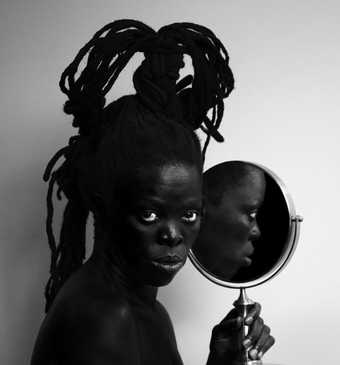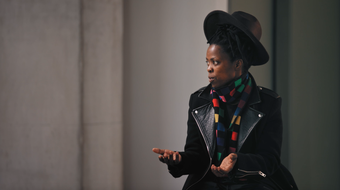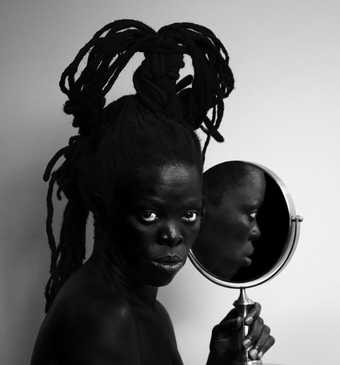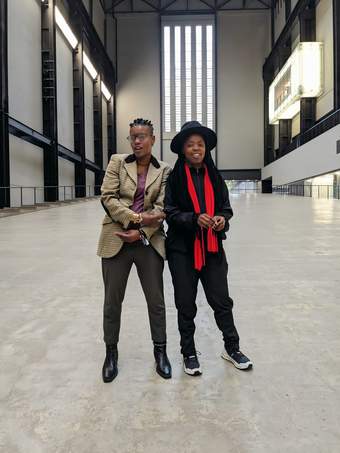
Zanele Muholi and Toya Delazy, courtesy of Carine Harmand
Listen to musician Toya Delazy’s Zulu sound baths, which explore the possibilities of sound as a form of healing. Delazy draws inspiration from encounters with her friend and collaborator Zanele Muholi, responding to the love, joy, pain and healing in their photographs.
Each sound bath responds to a different series of work in the exhibition and represents a different part of the human body. The pieces build until you reach ‘The head and pituitary gland’, composed in response to Somnyama Ngonyama (in room eight). Bringing together elements from each previous sound bath – or part of the body – Delazy’s climatic piece reflects ‘how individual experiences and expressions contribute to the collective human experience.’
Delazy's great-grandmother was Zulu praise singer Princess Magogo. Drawing from this legacy, as well as her own musical practice and lived experience, these sound pieces use the reactivation of sonic heritage as a form of healing. They celebrate the people in Muholi’s photographs while aiming to unite us in a shared journey of empathy and understanding.
I have chosen this approach because it reminds me of the ethos of our Bantu culture, Ubuntu, which means "I am because you are”. This concept emphasizes interconnectedness, community and mutual caring for all.
Toya Delazy
Only Half the Picture

Zanele Muholi, ID Crisis, 2003 © Zanele Muholi Courtesy of the Artist and Yancey Richardson, New York
Reproductive Glands
We get judged for half the picture – our reproductive glands – when it's only the beginning of our story. There is much more that makes us.
There is thunder and fire in the air, reflecting the clash of entities, spirit and flesh. The strings enter, stabbing across the density, keeping the time. Then the piano comes in, reminding us that life is a celebration. Suddenly the piano is cut, resembling how lives are cut drastically short by ignorance and discrimination.
Faces and Phases
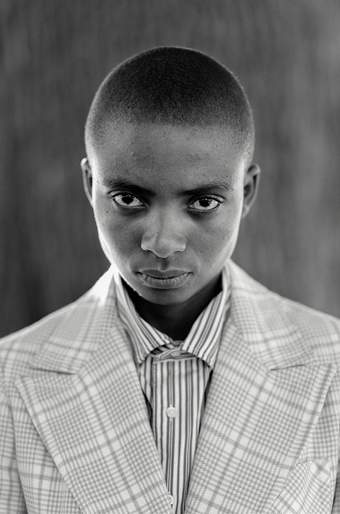
Zanele Muholi Lerato Dumse, Syracuse, New York Upstate 2015 © Zanele Muholi Courtesy of the Artist and Yancey Richardson, New York
Pancreas, heart and thymus gland
We live hard, love hard, fuck hard, laugh and cry. A life without passion must be the dullest sex, moaning, weak coffee type fresh hell I don't want to know. I want poetry with a dash of beautiful chaos. This piece reflects these dips and turns. Unfortunately for our community, the turns are much sharper. We are forever moving against the grain but making it beautiful. This soundscape includes words of love in multiple African languages.
Being
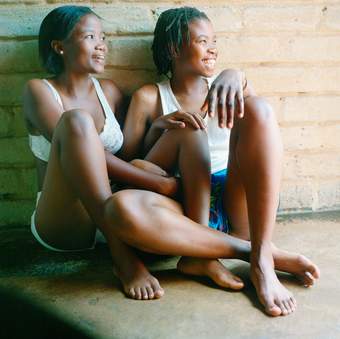
Zanele Muholi, Katlego Mashiloane and Nosipho Lavuta, Ext. 2, Lakeside, Johannesburg, 2007 © Zanele Muholi Courtesy of the Artist and Yancey Richardson, New York
Halo
If it weren't for the prayers of some of our grandmothers, many of us wouldn't be here. Many of our grandmothers loved us, no matter what the world thought about us. And they are the people who knew us the most. In Zulu culture, we never touch each other on the head as we see that as a place where the ancestors sit. This space is about that collective experience that brings us together. This piano piece honours the generations that came before us.
Queering Public Space
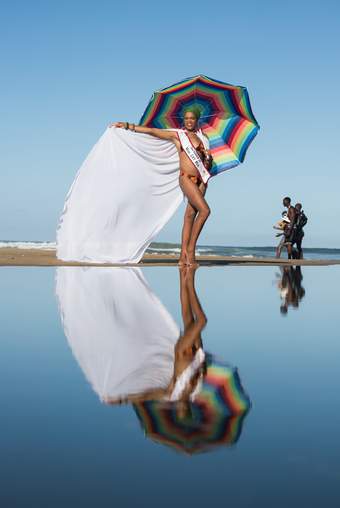
Zanele Muholi, Melissa Mbambo, Durban, 2017 © Zanele Muholi Courtesy of the Artist and Yancey Richardson, New York
Throat and thyroid gland
You cannot be what you cannot see. The vocals here are inspired by ancient Zulu hymns sung by my late great-grandmother Princess Magogo. She was a praise singer and, as such, a custodian of Zulu history and identity. This piece is based on a song that encourages warriors to keep hope after a defeat, to remember who they are and keep fighting. Troubles will come but we will overcome them.
Brave Beauties

Zanele Muholi, Miss Tee Menu, Parktown, Johannesburg, 2014 © Zanele Muholi Courtesy of the Artist and Yancey Richardson, New York
Eye and pineal gland
Silence is necessary for healing; you need to be comfortable with your own self. This sound bath begins with chimes, reminiscent of religious ceremonies. In Zulu spiritual culture, the chimes also represent presence – a moment to look directly into yourself. Unfortunately, many in our community run from silence because it was imposed on us for so long. But eventually, you have to stop running and allow the pain. That’s how you heal – by letting the feelings go through you.
Somnyama Ngonyama
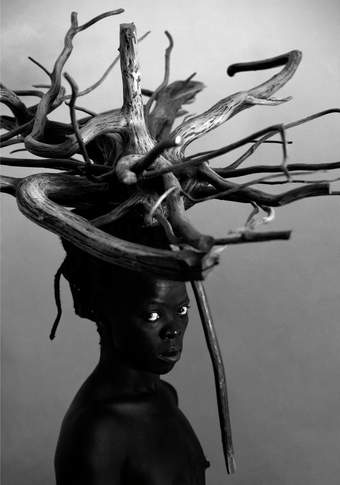
Zanele Muholi, Jula I, Wild Coast 2020, © Zanele Muholi Courtesy of the Artist and Yancey Richardson, New York
Head and pituitary gland
This piece brings together extracts from each sound bath in the exhibition. Creating a climatical sonic experience, it acts as a collective moment of healing. Our head, eyes and face play a large role in how we connect to the rest of the world and what we believe about ourselves. There are also hidden wounds that make us think we’re not enough. But I hope you are seen as the magnificent gift of soul and energy that you are.
Collectivity

Zanele Muholi, Lerato Dumse, Muntu Masombuka’s Funeral, Johannesburg, 2014 © Zanele Muholi. Courtesy of the Artist and Stevenson, Cape Town/Johannesburg and Yancey Richardson, New York
Guts and adrenal gland
Breath: the sound of the first signs of life. If a baby doesn't cry, it hasn't taken its first breath. The sound here intertwines with chants to simulate the movement of breath. There is lot of optimism here: coming into being, realising one exists.

